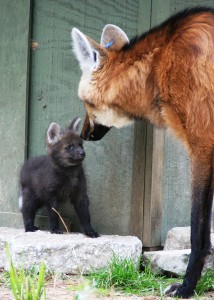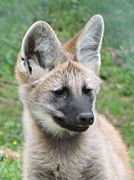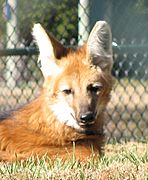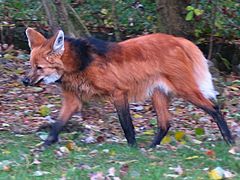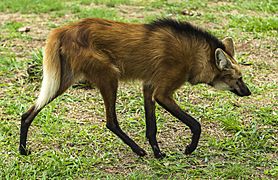Maned wolf facts for kids
Quick facts for kids Maned wolf |
|
|---|---|
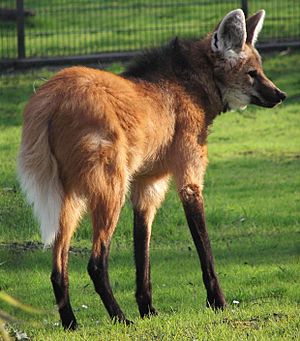 |
|
| Maned wolf in Cologne Zoo, Germany | |
| Conservation status | |
| Scientific classification | |
| Genus: |
Chrysocyon
|
| Species: |
brachyurus
|
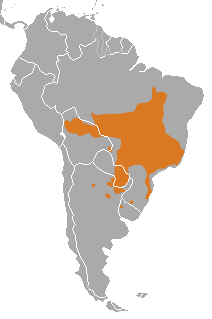 |
|
| Range of the maned wolf | |
| Synonyms | |
|
Canis brachyurus, C. campestris, C. isodactylus, C. jubatus, Vulpes cancrosa |
|
The maned wolf (Chrysocyon brachyurus) is a large canine animal. It lives in South America. Even though it looks a bit like a fox and a wolf, it is neither. It's actually the only species in its own genus called Chrysocyon. This name means "golden dog".
Contents
What's in a Name?
The name "maned wolf" comes from the special mane (long hair) on its neck. In the Guaraní language, people call it aguara guasu, which means "large fox". In Spanish, it's known as lobo de crín, lobo de los esteros, or lobo colorado. In Portuguese, it's lobo-guará. The word lobo means "wolf" in Latin. The words Guará and aguará come from an old language meaning "by the fuzz". In Bolivia, it's also called borochi.
Where Do They Live?
Maned wolves live in several South American countries. You can find them in Argentina, Brazil, Bolivia, Peru, and Paraguay. They are almost gone from Uruguay. These animals are good at living in open areas. They prefer the savannas of South America.
They like open and semi-open habitats. This includes grasslands with some bushes and trees. They are common in the Cerrado region of Brazil. They also live in Paraguay, northern Argentina, and parts of Bolivia and Peru. Sadly, they are very rare in Uruguay. This is likely because their homes have been destroyed.
What Do They Look Like?
The maned wolf is the biggest canine in South America. It weighs about 20 to 30 kilograms (44 to 66 pounds). It can stand up to 90 centimeters (35 inches) tall at its shoulders. It has long, thin legs and a thick reddish coat. This makes it easy to spot.
Its long legs help it move through the tall grasses where it lives. Its fur can be reddish-brown or golden orange. Its legs are black, and it has a clear black mane. It also has a white tuft of fur on its tail tip. A white "bib" is found under its throat. The mane stands up when the wolf feels threatened. This makes it look bigger and more aggressive.
Very rarely, maned wolves can be all black. The first photo of a black adult maned wolf was taken in Brazil in 2013. Maned wolves are also famous for the strong smell of their territory markings. This smell is so strong that they are sometimes called "skunk wolves." They prefer to live in grasslands, scrub prairies, and forests.
How Do They Behave?
The maned wolf is a solitary animal. This means it lives alone and does not form packs.
It usually hunts by itself. This happens between sunset and midnight. It uses its large ears to listen for prey hiding in the grass. It might tap the ground with a front foot. This helps to scare out small animals. Then, it pounces to catch them. It kills its prey by biting the neck or back. If needed, it shakes the prey hard.
The maned wolf is most active during twilight hours. This means early morning and early evening. They are usually busy between 8 and 10 AM, and 8 and 10 PM. On cool or cloudy days, they might be active all day long. They probably use open fields to find food. They rest in more covered areas, like riparian forests, especially when it's hot.
They mostly communicate by scent marking their territory. They also make a loud sound called "roar-barking."
Reproduction and Life Cycle
Maned wolves mate from November to April. The mother carries her babies for 60 to 65 days. A litter can have two to six pups. The pups are born with black fur. Each pup weighs about 450 grams (16 ounces). They are fully grown by one year old. During their first year, the pups depend on their parents for food.
Pups are born weighing between 340 and 430 grams (12 to 15 ounces). Their fur is black at birth. It turns red after about 10 weeks. Their eyes open when they are about 9 days old. They drink their mother's milk for up to 4 months. After that, their parents feed them by regurgitating food. This starts around three weeks of age and lasts up to 10 months.
When pups are three months old, they start to go with their mother when she looks for food. Both male and female parents help care for the pups. However, the female usually does most of the work. Maned wolves become adults at one year old. At this age, they leave their birth territory.
It can be hard for maned wolves to have babies in the wild. Many young pups do not survive. Females might not have babies for up to two years. Breeding them in zoos is also difficult.
We don't know how long maned wolves live in the wild. But in zoos, they can live between 12 and 15 years. One maned wolf at the São Paulo Zoo lived to be 22 years old!
What Do They Eat?
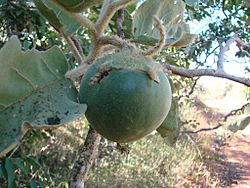
The maned wolf is an omnivore. This means it eats both plants and animals. It hunts small and medium-sized animals. These include small mammals like rodents and rabbits. They also eat birds and their eggs, reptiles, and even fish. They might also eat snails, other molluscs, and insects.
But a big part of their diet is plants. More than half of what they eat can be plant matter. This includes sugarcane, tubers, bulbs, roots, and fruit. Scientists have found over 300 different food items in their diet. This includes 116 types of plants and 178 animal species.
Maned wolves hunt by chasing their prey. They might dig holes or jump to catch birds flying by. About 21% of their hunts are successful. They have been seen chasing Pampas deer. They also eat dead animals they find. Studies of their poop show they eat giant anteaters, bush dogs, and collared peccarys. We don't know if they hunt these animals or just eat them after they die. Armadillos are also a common food. They eat more animals during the dry season.
The wolf apple (Solanum lycocarpum) is a very important food for them. This fruit looks like a tomato. It makes up 40 to 90% of their diet, with some exceptions. Maned wolves actively look for wolf apples. They eat them all year long. Other fruits are only eaten a lot during the rainy season. Maned wolves can eat many fruits at once. They help spread the seeds of these plants.
Maned wolves are flexible about where they live. They can survive in places changed by humans. This includes burned areas or places with lots of people. Burned areas have small mammals like the hairy-tailed bolo mouse and vesper mouse. The wolves can hunt these to survive.
In the past, maned wolves in zoos were fed mostly meat. This caused them to get bladder stones. Now, their zoo diets include fruits and vegetables. They also get special food made for them. This food is low in things that cause stones.
How They Interact with Other Species
Maned wolves help other living things. They help spread seeds of the plants they eat. They do this when they poop. Maned wolves often poop near leafcutter ant nests. The ants then use the poop to help their fungus gardens grow. But they throw out the seeds from the poop. These seeds land in piles outside their nests. This helps the seeds grow much better.
Maned wolves can get ticks, especially from the Amblyomma group. They can also get flies like Cochliomyia hominivorax, usually on their ears. Interestingly, they don't get many fleas. When they share areas with pet dogs, they can catch diseases from them.
Their main predators are large cats. These include the puma (Puma concolor) and the jaguar (Panthera onca). Jaguars are the most common predators of maned wolves.
Maned Wolves and Humans
Maned wolves are usually shy. They run away if they feel scared. So, they are not a big danger to humans. People sometimes think maned wolves steal chickens. In the past, they were thought to be a threat to cattle, sheep, and pigs. But now we know this is not true.
Historically, in some parts of Brazil, people hunted these animals. They used some body parts, like the eyes. They believed these parts brought good luck.
The Brazilian government now lists the maned wolf as a vulnerable species. This means it gets more care and protection.
Maned wolves are threatened by habitat loss. They are also hit by cars on highways. Wild and pet dogs can give them diseases. Dogs have also been known to attack them.
Maned wolves live in several protected areas. These include Caraça and Emas National Parks in Brazil. Many zoos around the world have maned wolves. They have been successfully bred in zoos. This is especially true in Argentina, North America, and Europe. In 2012, over 3,200 maned wolves lived in more than 300 zoos. The Smithsonian National Zoo Park has worked to protect maned wolves for almost 30 years. They help coordinate a plan to breed maned wolves in zoos. They also study them in the wild. They work to protect their homes and teach people about them.
Conservation Efforts
The IUCN does not consider the maned wolf an endangered species. This is because they live in many places. They can also adapt to areas changed by humans. However, their numbers are going down. So, they are now listed as near threatened.
The Brazilian Institute of Environment and Renewable Natural Resources calls them a vulnerable species. It is against the law to hunt maned wolves in all countries where they live.
Because of deforestation and more cars on roads, wolves are often hit. Cities are also growing. This makes wolves move to urban areas to find food. This means they have more contact with pet animals. This increases the risk of diseases for the wolves, which can lead to death.
People who work to protect animals are taking steps to help maned wolves survive. This is very important as cities continue to grow into their natural homes.
In Human Cultures
People have different ideas about the maned wolf. Some fear them, some tolerate them, and some dislike them. In some parts of Brazil, people believe that parts of the wolf's body can cure illnesses. These include bronchitis, kidney disease, and snake bites. They also believe these parts bring good luck. These parts can be teeth, the heart, ears, or even dry poop. In Bolivia, riding a saddle made of maned wolf leather is thought to protect from bad luck. But people don't use parts of this animal on a large scale.
In Brazilian cities, people usually feel good about the maned wolf. They don't see it as a hunting animal or a pest. They often think it's important to protect them. Even though people think they are strong and fierce, they don't see them as dangerous. Even though they are popular in some places and common in zoos, many people don't know about them. Studies in Brazilian zoos showed that up to 30% of people didn't know or couldn't recognize a maned wolf.
The Guaraní people thought the maned wolf was a common animal. Early European explorers used the same names for it as the native people. Spanish naturalist Felix de Azara also used the Guarani name. He was one of the first to describe the animal's biology. He thought it was an important part of Paraguay's wildlife. Some negative ideas about the maned wolf stealing chickens came from European beliefs. European farmers often had problems with wolves and foxes.
The maned wolf rarely causes problems for people where it lives. Because of this, it has become a symbol for protecting the Brazilian cerrado region. It is shown on the 200-reais banknote, which came out in September 2020. It was also on the 100-cruzeiros reais coin, used in Brazil from 1993 to 1994.
Gallery
See also
 In Spanish: Aguará guazú para niños
In Spanish: Aguará guazú para niños



